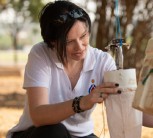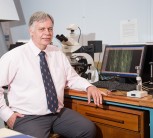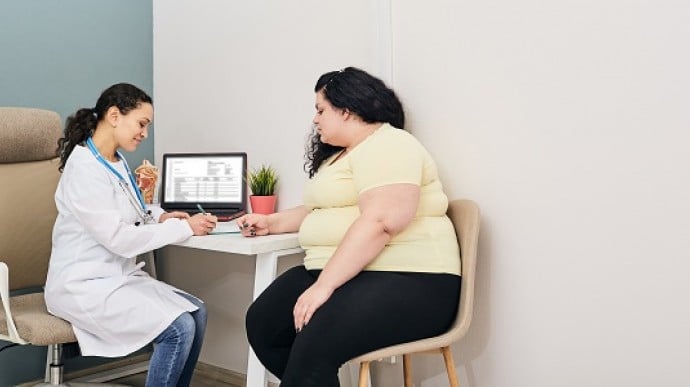Malaria is a complex disease that has devastated Africa and parts of South Africa. Researchers at the University of Pretoria Institute for Sustainable Malaria Control are combining research disciplines to understand and control malaria.
Malaria is an often lethal disease, caused by the Plasmodium parasite and transmitted by female Anopheles mosquitoes. It is endemic to large parts of Africa, including a few regions in the northeastern corner of South Africa.
In particular, the Vhembe region in Limpopo remains a malaria hotspot despite an indoor residual spraying (IRS) programme, where houses and buildings are sprayed annually with an insecticide to limit transmission of the disease.
IRS is not an ideal solution, however. The insecticide used in traditional mud huts is dichlorodiphenyltrichloroethane (DDT), which may cause environmental problems and damage human health. In addition, malaria remains a constant problem in the area due to ineffective control in neighbouring Zimbabwe.
In order to meet South Africa’s plan to eliminate malaria from the country by 2018, innovative approaches to control are needed.
The University of Pretoria Institute for Sustainable Malaria Control (UP ISMC) is taking a transdisciplinary approach to malaria control, with a special focus on communities in the Vhembe area. Researchers work with the communities to understand their needs and to pilot new technologies and solutions to the challenges of malaria control in South Africa.
Among a wide range of projects at the Institute, three stand out as examples of the transdisciplinary, innovative and inclusive research pioneered by the UP ISMC.
The Institute has developed wall linings impregnated with insecticide, and tested them in Vhembe. The communities there approve of the intervention, and after four years (based on tests in the laboratory) they remain an effective way to control mosquito populations and limit transmission of malaria.
Another project is using a cellphone app known as mSpray to better track and record the details of the IRS programme in the Vhembe area. This will help limit the toxic effects of DDT on human populations and reduce the time and effort spent monitoring IRS programmes. The mSpray app could potentially be rolled out countrywide or even internationally. Malaria Buddy is another app developed at the UP ISMC, which provides malaria risk and symptom information for travellers in malaria regions.
Another very important project in the area is looking at the effects of DDT and other common insecticides on fertility, birth defects and childhood brain development. Researchers are studying mother-child pairs to understand how the mother’s exposure to insecticides impacts on the child. It is well-known that these insecticides potentially can cause health problems, and so understanding the impact more clearly will help to limit the health impact of IRS.
Malaria-spreading mosquitoes have a particular set of environmental factors that need to be just right for them to thrive. Mr Abiodun Morakinyo Adeola, a doctoral student at the UP ISMC, has combined this knowledge with satellite data to predict malaria outbreaks and to find the areas and populations most at risk.
People involved
Prof Tiaan de Jager
Director: UP Institute for Sustainable Malaria Control (UP ISMC)
Focus area - Public health, Environmental health, Malaria, Toxicology, Reproductive health
Prof Riana Bornman
Extra-Ordinary Professor in Andrology, Department of Urology at the Faculty of Health Sciences.
Focus area - Since 2002, her public health focus has been on health effects in malarial areas where insecticides like DDT are applied for mosquito vector control with inadvertent exposure of humans and the environment. She has done extensive research in communities of the Vhembe district of Limpopo, using local VhaVenda women for training, recruitment and data collection.
Prof Rhena Delport
Head of the Skill Laboratory, Faculty of Health Sciences
Focus area - environmental exposure,cardiovascular disease, medical education and medical professionalism.
Dr Natalie H. Aneck-Hahn
Director: Environmental Chemical Pollution and Health (ECPH) Research Unit at UP
Focus area - health and medical sciences, with a specialisation in male reproduction, endocrine disrupting chemicals and health-related water quality
Prof Walter Focke
Director: Institute of Applied Materilas (IAM)
Focus area - Polymer technology use for the controlled release of actives, for physical methods of vector control.
Dr Taneshka Kruger
Senior project coordinator: UP ISMC, operational and administrative support within the UP ISMC
Focus area - Malaria education and health promotion, alternative vector control methods.
Prof Clifford Mutero
Coordinator of Malaria IVM Programme activities at ICIPE
Focus area - Malaria vector ecology and behaviour; Integrated vector management, and multi-sectoral malaria control policy-making
Dr Mthokozisi Sibanda
Postdoc student in the Department of Chemical Engineering
Focus area - development of polyolefin fabrics as slow release devices for insecticides/repellents
Ms Mildred Ramothole
MPH student in the SHSPH.
Focus area – Long-term acceptability of wall linings in the Vhembe area.
Prof Piet J. Becker
Focus area - Prof Becker is a biostatistician in the Faculty of Health Sciences. He assists with statistics on numerous research projects (staff and postgraduate student research).
Researchers at the University of Pretoria Institute for Sustainable Malaria Control have developed insecticide-impregnated wall linings to protect residents in Vhembe, Limpopo. The wall linings have been so successful at reducing mosquito bites that residents have kept them in their homes for the long-term.
Researchers at the University of Pretoria Institute for Sustainable Malaria Control (UP ISMC), and specifically chemical engineers in the Institute of Applied Materials (IAM) at UP, have developed a polyethylene wall lining that is impregnated with insecticidal chemicals. This innovative mesh material was installed in homes in the Vhembe district to test their efficacy, and to get feedback from the community.
Using wall linings for mosquito control reduces health risks because normal sprayed insecticides coat dust particles, leading to unavoidable human exposure through contaminated dust on furniture, on floors and in the air. This dust can also contaminate food and water in sprayed homes.
The UP ISMC initiated a six-month pilot study to see whether the linings were acceptable to the community. The response was positive so the researchers decided to leave the linings in the homes of participants to see how long they remained effective. These linings have now been in the field for the last four years, and the results have far exceeded the researchers’ expectations. This pilot project was undertaken in an area of a village where insecticides were not sprayed.
The linings contain the insecticides deltamethrin and alpha-cypermethrin, which show some toxicity to humans, but to a far lesser extent than a commonly used insecticide like DDT. To limit human contact, linings are installed out of reach of children, and families are instructed not to touch the material.
The researchers have found that the linings remain close to 100% effective in killing mosquitoes, even after four years. Specifically, mosquitoes are knocked down within 30 minutes of contact with the linings, and die within 24 hours in laboratory tests. Importantly, the linings remain well above the World Health Organisation (WHO)’s recommended minimum effectiveness for internal wall linings. Reports from communities corroborate these results, as community members reported less biting and less annoyance overall.
The feedback from community members who were included in the study and have now taken possession of their wall linings, has been overwhelmingly positive. “Those who have moved house have asked if we can move the linings from their original position because it is so effective”, said Dr Taneshka Kruger, senior project coordinator at the UP ISMC.
The UP ISMC now has a commercial partner for further development of this innovative malaria control technology. The company has also conducted their own tests on the wall linings to better understand its qualities, including how long the linings will remain effective after washing.
Dr Kruger says the next steps will be 1) to conduct phase two field trials using trial buildings where mosquitoes that die through contact with the lining can be counted accurately, 2) to improve how the linings are fastened to the walls, and 3) to look at alternative insecticide options - especially WHO-approved insecticides.
“The wall linings are going to remain in the huts and the houses for as long as the people want them there and we hope that phase two will start as soon as possible,” said Dr Kruger..
As the fight against malaria intensifies, researchers at the University of Pretoria Institute for Sustainable Malaria Control are turning to digital platforms to control and monitor the disease.
The University of Pretoria Institute for Sustainable Malaria Control (UP ISMC) has worked on a number of technological innovations for malaria control and prevention. These include the mSpray app and the Malaria Buddy app.
mSpray focusses on the problem of data management in malaria control, specifically for the annual indoor residual spraying (IRS) programme. Until recently there was no centralised digital database to ensure that spraying was effective, regular and safe.
Data was managed manually, leading to problems of ineffective insect control or environmental and human toxicity. Another issue is the potential for human error and the time delays inherent in using an analogue system to store data.
“Previously, the spray workers would go into the houses, spray the walls and fill in cards,” says Prof Tiaan de Jager, director of the UP ISMC. “For the next malaria season they would go back and spray the houses, but there was no clear database recording what exactly was sprayed where.”
The app works by allowing spray workers to record information about pesticides sprayed, the number of structures sprayed, concentrations and application procedures - all on their cellphones. This reduces the time needed to record or access data and ensures a safer and more effective IRS programme. Over time, this could develop into a comprehensive database of spraying patterns in specific areas, which can be used to improve IRS strategies and reduce spraying costs and human health impacts.
mSpray was developed at the University of California Berkeley (UCB) with input from UP ISMC researchers. The app was piloted in the Vhembe district of Limpopo province in the 2012/2013 spraying season. Prof de Jager hopes to scale up the mSpray application to the whole of Limpopo for the 2016/2017 season, and to the whole of South Africa beyond that.
Originally, the UP ISMC intended to develop mSpray into a surveillance system to be used by the National Malaria Control Programme. As the National Department of Health has since started developing their own surveillance system however, the UP ISMC will support that initiative instead.
Researchers developed another app called Malaria Buddy in collaboration with travel company Travel With Flair, aimed at providing information on malaria risk, prevention and symptoms to travellers in malaria endemic areas. The app is available for Android and iOS, and researchers are currently designing an updated version that will include GPS technology to direct users to the nearest healthcare centre if symptoms are detected. The app was launched earlier in 2016.
Professor de Jager is enthusiastic about using mobile technology to combat malaria. “We should continue to use cell phone technology as it is much more effective than manual means in controlling malaria.”
The use of DDT and other insecticides has contributed immensely to controlling malaria in South Africa. Researchers at the University of Pretoria Institute for Sustainable Malaria Control have been looking into the negative health effects of these malaria control measures.
An important focus area at theUniversity of Pretoria Institute for Sustainable Malaria Control (UP ISMC) is understanding the developmental effects of constant exposure to insecticides on populations in the Vhembe district of Limpopo Province, and particularly in children. It is widely known that DDT potentially causes health problems, but the exact effects of indoor residual spraying (IRS) are not well-understood. According to Prof Tiaan de Jager, director of the UP ISMC, this research was prompted by reports of poor reproductive health in the Vhembe area.
The UP ISMC has conducted a number of studies in Vhembe to understand the effects of DDT exposure on men, women and children, specifically looking at thyroid levels, birth difficulties and neurodevelopment during the first two years of life.
The researchers found that DDT exposure in particular leads to endocrine disruption, which means that it interferes with hormones in the human body. The UP ISMC has shown that this causes a decrease in retinol binding protein, limiting vitamin A uptake and leading to deficiencies.
They have shown that the high concentrations of environmental DDT in Vhembe affects semen quality in young men, reducing fertility and leading to birth defects. Researchers also found that boys whose mothers had been exposed to DDT spraying showed a high rate of urogenital birth defects.
Another important finding is that DDT and dichlorodiphenyldichloroethylene (DDE, a common DDT breakdown product) levels in dust are an accurate measure for insecticide exposure in people who live in IRS areas. This will make future studies of DDT exposure simpler.
The world-wide use of DDT is controversial and this controversy has not escaped de Jager: “We acknowledge that we are still dependent on the use of DDT and other pesticides, but we need to communicate, educate and make people aware of the potential risk.”
The use of DDT and other insecticides has contributed immensely to controlling malaria in South Africa. Since an alarmingly sharp rise in the year 2000, the incidence of malaria has significantly decreased due to a more efficient use of DDT and better access to anti-malarial drugs.
These findings were based on a number of individual studeis at UP ISMC over the last few years.
In the fight to control malaria, researchers at the University of Pretoria Institute for Sustainable Malaria Control have turned to satellite data to get a heads-up on malaria outbreaks. #UPResearchMatters
Satellite surveillance, detailed risk maps and early-warning systems are now being deployed to combat the world’s deadliest animal, the malaria-transmitting female Anopheles mosquito. This is thanks, in part, to the doctoral studies of Dr Abiodun Morakinyo Adeola from the University of Pretoria Institute for Sustainable Malaria Control (UP ISMC).
Adeola developed risk maps of malaria outbreaks so that the UP ISMC were able to facilitate the targeting of insecticide spraying to the most affected areas.
Malaria-spreading mosquitoes have a particular set of environmental factors that need to be just right for them to thrive; Mr Adeola used geographic information systems (GIS) and advanced satellite imaging to find out what these are so that outbreaks can be better predicted.
Mpumalanga is one of the three provinces most affected by malaria, but it has received comparatively less research attention than areas in the KwaZulu-Natal and Limpopo provinces, where concerted control efforts have put a significant dent in malaria occurrences.
Adeola used remote sensing data to identify mosquitoes’ favoured breeding spots. He plotted these areas onto a risk map that showed the factors that correspond with the prevalence of female Anopheles mosquitoes. He also looked at how members of the population in Nkomazi, Mpumalanga were affected by malaria and found that working males were at the greatest risk of contracting malaria and that this was linked to agricultural activity in Nkomazi.
"Studies in the past have been able to show a link between malaria occurrence and agriculture," he says. "Little ponds within the farms and vegetation allow mosquitoes to breed and thrive."
Adeola confirmed that most of the working male population in the area are employed in these high risk farming spots on the map.
Next he looked into how malaria prevalence relates to immigration. He calls the phenomenon of immigrants bringing the disease with them into new areas the “importation of malaria”, and it occurs very often in South Africa. He thus identified malaria importation as a significant setback in the fight to control the disease.
Finally, Adeola used remote sensing to develop an early-warning system for malaria outbreaks. He was able to forecast malaria occurrences from three to six months in the future with incredible accuracy. Predictions using his model were correct nine out of 10 times in all five villages studied. This level of accuracy is on par with the World Health Organisation’s standards.
Looking forward, Adeola believes his model can be further strengthened with more funding and higher-resolution data. He believes that adding additional factors, such as migration could improve the accuracy of his predictions even further.
The model can also be adapted to other environment-dependent diseases such as cholera.
People involved
Dr Abiodun Morakinyo Adeola
Dr Abiodun Morakinyo Adeola PhD at the UP ISMC looked at using satellite surveillance and early-warning systemsto combat malaria.
Dr Abiodun Morakinyo Adeola, Prof Tiaan de Jager, Prof Riana Bornman, Prof Rhena Delport, Dr Natalie H. Aneck-Hahn, Prof Walter Focke, Dr Taneshka Kruger, Prof Clifford Mutero, Dr Mthokozisi Sibanda, Ms Mildred Ramothole & Prof Piet J. Becker
January 1, 2015




Professor Focke holds BEng and MEng degrees from the University of Pretoria (UP) and a PhD from the Massachusetts Institute of Technology. In 1997, he joined UP, where he is Director of the Institute of Applied Materials.
Prof Focke says that there are ample opportunities to engage in multidisciplinary research at UP. “The Institute for Sustainable Malaria Control is an excellent example of a vehicle that makes this possible,” he says. “It brings together medical researchers, scientists, engineers, entomologists, economists, artists and so forth, allowing them to collaborate to achieve a common goal – the elimination of malaria.”
Prof Focke’s current research interest is push-pull insect control, with a focus on controlled release devices for attractants and repellents.
His earlier materials research centred on chemical and polymer technology, while his carbon technology research explored the use of graphite in energy applications and as a flame-retardant additive for plastics. Work on clay and polymer additive technology was targeted towards additive applications in polymers in order to improve thermo-oxidative stability and flame retardancy, to facilitate the controlled release of actives, especially for malaria vector control and to modulate moisture transmission through polymer films. The objective of his pyrotechnics research was to develop “green” compositions for use as time delays and to initiate compositions in chemical mine detonators.
Within his academic discipline, Prof Focke works mainly on controlled release devices to enable malaria vector control and push-pull insect control in agriculture. Cross-faculty, the malaria vector control activities involve researchers from several departments and faculties.
Prof Focke’s field of research contributes to the betterment of the world because eliminating malaria will reduce suffering in sub-Saharan Africa and improve public health. He adds that push-pull insect control holds the promise of more sustainable agricultural practices.
A recent highlight for the professor was the development of bicomponent fibre technology, which enables active textiles. Dr Mthokosizi Sibanda, who was the main driver of this technological development, established African Chemicals, a high-technology business, to exploit this intellectual property. African Chemicals is developing various textile-based products with insecticidal or insect repellence properties.
Prof Focke was prompted to determine whether the Institute for Sustainable Malaria Control could help to reduce the burden of malaria by applying chemical engineering principles to malaria vector control after both his son-in-law and one of his grandchildren were admitted to intensive care upon contracting malaria.
His research matters, he says, because it aims to address real-world problems and, in the process, train high-level men and women who can contribute to the economic development of South Africa.
His advice to school learners or undergraduates who are interested in his field is to find an area that interests and excites them, as that is the secret to a successful career.
In his free time, Prof Focke enjoys walking in the veld with his dogs, collecting rocks and taking pictures of wildflowers.

Dr Natalie Aneck-Hahn has been in the field of Andrology for more than 26 years and is the Deputy Director Medical Natural Sciences in the Department of Urology and head of Andrology at the Steve Academic Hospital. She is also the Director of the Environmental Chemical Pollution and Health (ECPH) Research Unit at the School of Health Systems and Public Health at the University of Pretoria.
Dr Aneck-Hahn’s research focus is on the effect of endocrine disrupting chemicals on male
reproductive health and in the environment. She has authored and co-authored several technical reports
and peer reviewed publications.
 Story
Story
University of Pretoria (UP) researchers have found that the antioxidant content of certain types of tea can be likened to that found in recommended portions of fruit and vegetables.
 Infographic
Infographic
Half a cup of black tea, oolong tea or green tea contained the same amount of antioxidants with radical scavenging capabilities (RSC) as that of a 200mg vitamin C tablet.
 Story
Story
Researchers at the University of Pretoria (UP) may have identified the gene that is responsible for diet-related obesity. By exploring the role of the novel gene Slc7a8, they have made a potential breakthrough in current knowledge about the cellular mechanisms that drive fat accumulation. This understanding is crucial in developing effective treatments.
Copyright © University of Pretoria 2025. All rights reserved.
Get Social With Us
Download the UP Mobile App